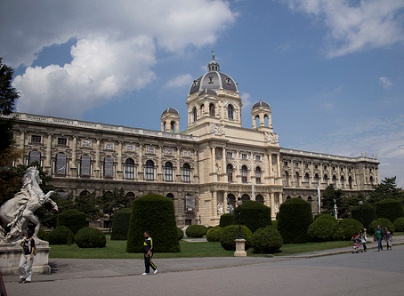

Burgring 7, A- 1014
Tel. 01- 521 7700
Subway: Volkstheater
Bus:2A, 48A
Trolley: 2, D, J, 46, 49
Open: 9am- 6:30pm Thu- Mon (to 9pm Wed)
Closed: Jan 1, May 1, Nov 1, Dec 25
www.nhm-wien.ac.at
Naturhistorisches Museum or Museum of Natural History was opened in 1889 include a huge collection of archaeological, anthropological, mineralogical, zoological and geological displays. Among its most interesting collections is a collection of human skulls. The largest display of this kind shows human evolution over the centuries. Another interesting artifact in Naturhistorisches Museum is Venus of Willendorf, 24,000 year old Palaeolithic fertility statue. Many other human artifacts from prehistoric times as well as dinosaur fossils are found here. In case you were wondering on why does Naturhistorisches Museum looks a lot like Kunsthistorishes Museum the answer is simple. They were designed by the same architect. He did not bother himself with multiple designs so chose one and used it for both museums.
Around 1750, Emperor Franz I Stephan von
Lothringen, the husband of the Austrian monarch Maria Theresia,
co-ruling in the Habsburg hereditary lands, bought the largest
collection of natural objects from the Florentine Johann Ritter von
Baillou (1679–1758) at that time. The heart of the collection was
formed by 30,000 objects, including rare snails, corals, shells, as
well as precious gemstones and rare minerals. Even then, the
collection was organized according to scientific criteria.
Over time, the collections became so extensive that the Hofburg's
premises no longer offered enough space. In the course of the
demolition of the outdated Vienna city wall and the construction of
the Ringstrasse, which had been commissioned by Franz Joseph I for
Christmas 1857, the city expansion fund, which was commissioned to
sell the land, also provided space for new buildings for two court
museums, the natural history and the art history. At that time, the
natural history collections were no longer privately owned by the
House of Habsburg-Lorraine, but were defined as court ark, state
assets managed directly by the imperial court; the art history
collections were owned by the family funds of the imperial family.
The court of the emperor therefore acted as the client for the two
museum buildings.
The architect was identified from 1867 in a
competition in which Karl Hasenauer took part; the emperor had
Hasenauer's plans examined by Gottfried Semper, and Hasenauer won
him over to the collaboration. This resulted in a not always
harmonious collaboration between the two architects at both museums.
The construction of both court museums began in 1871, six years
after the opening of the Ringstrasse; the Kunsthistorisches Museum
was opened in 1891, two years later than the NHM. The building is
crowned by a dome that rises to a height of 65 meters and bears a
colossal bronze statue of the Greek sun god Helios - symbol of the
all-living element in nature. This figure, like the Pallas Athena on
the dome of the Kunsthistorisches Museum, was created by Johannes
Benk.
The arrangement of the two museum buildings across the
Ringstrasse was designed to frame a monumental Imperial Forum with
two new wings of the Hofburg to be connected on the other side of
the street and the historic front of the Hofburg (see also
Heldenplatz), which, due to the end of the monarchy in 1918 Torso
remained. From 1881, Semper and Hasenauer built one of the two
planned new wings of the Hofburg, the so-called Neue Burg, between
the Kunsthistorisches Museum and the Hofburg. And they built the new
k.k. on another part of the Ringstrasse in 1874–1888. Hof
Burgtheater.
The NHM, a federal museum under the supervision
of the Ministry of Education since 1920, underwent an unremarkable
development in the following decades. Republican Austria, which had
become small, did not raise the funds to design the NHM in line with
newer museological findings or to expand the collections through
sensational acquisitions. During the reign of the National
Socialists, 1938–1945, the museum received holdings from “Aryanized”
Jewish property. The last general director appointed before the Nazi
era in 1933, Hermann Michel, who was deposed in 1938, acted again as
such from 1947–1951. After 1945, the return of illegally acquired
objects to the rightful owners across Austria was not a major
concern of politics and administration for decades. It was not until
the restitution regulations, which were adopted due to international
pressure in the 1990s, that the state collections, including the
NHM, felt compelled to systematically search for objects to be put
back.
Since 1978, the so-called race hall has existed in the
NHM, in which the evolution of humans towards human races with
various show pieces and the accompanying texts evaluating them has
been presented. In 1993, the British anthropologist Adam Kuper
criticized the showroom as a manifestation of "Nazi-like racial
research". The exhibition was closed in 1996 only after a series of
articles about it in the Vienna city newspaper Falter and several
parliamentary questions from the Greens to the responsible minister
of science. The opening of the completely redesigned anthropological
halls took place in January 2013.
The Federal Museum Law,
which was passed for the first time in 1998 and amended in 2002,
made it possible to separate the NHM from January 1, 2003 as a
scientific institution under public law with its own legal
personality from the federal administration. On July 8, 2003, also
due to the museum regulations of the Natural History Museum of
December 20, 2002, it entered into force on January 1, 2003 with the
commercial register number 236724z.